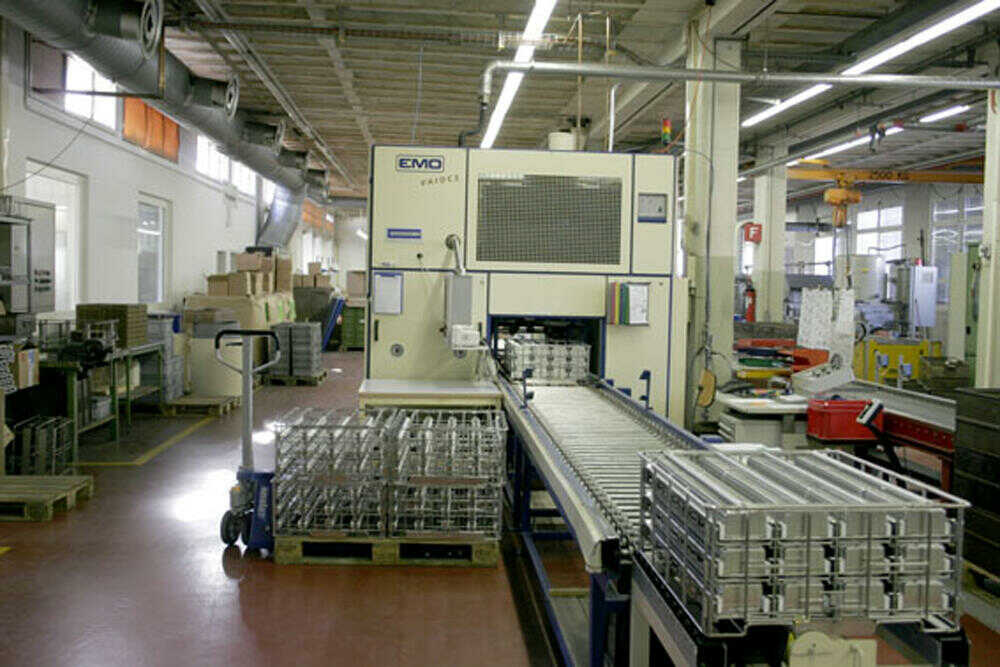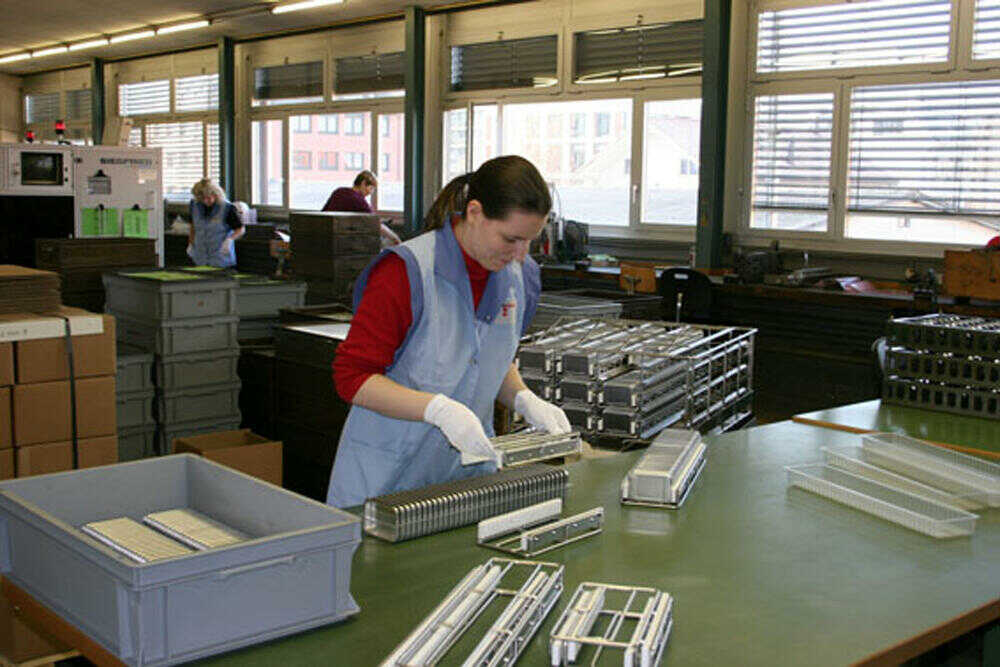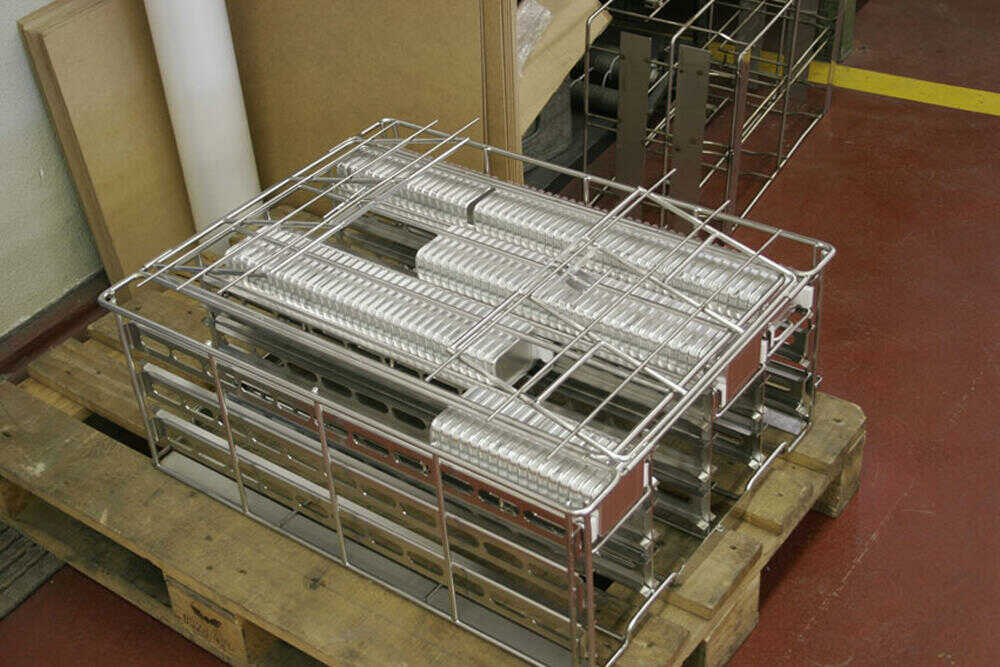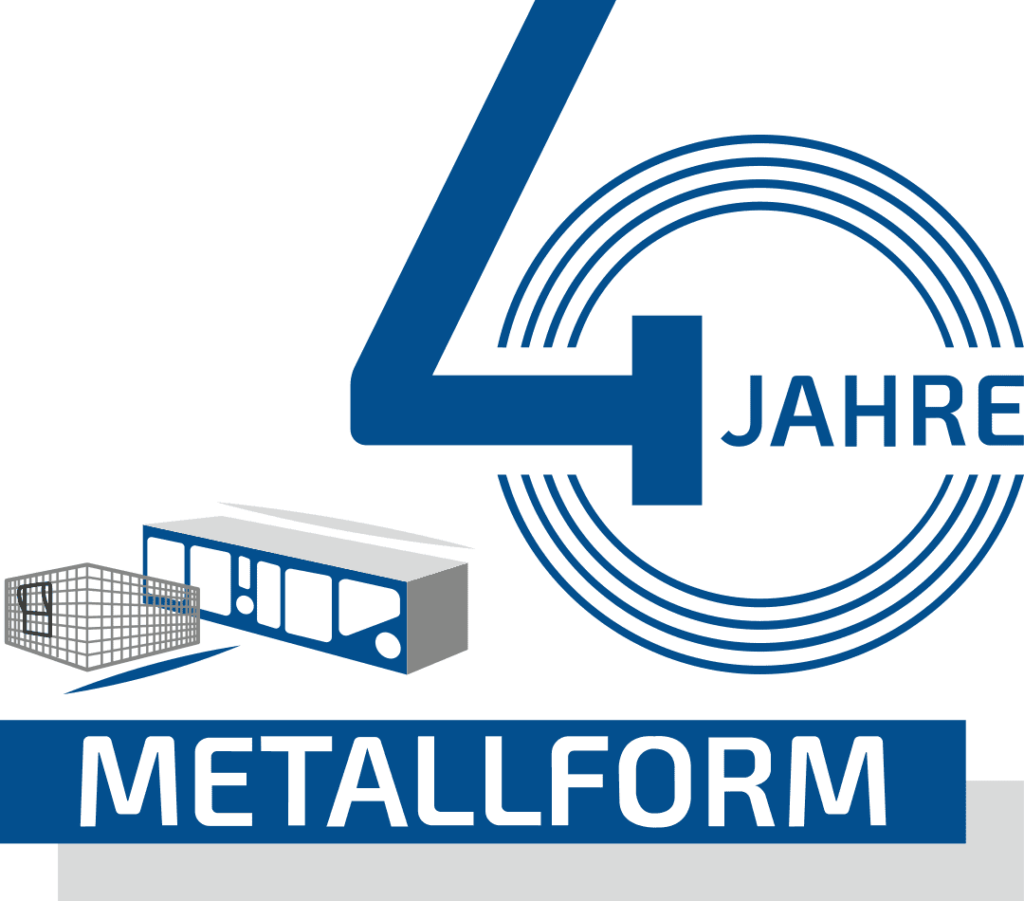Oskar Rüegg AG
On the one hand, components for the automotive industry have to meet high quality standards. On the other hand, the high cost pressure in this sector requires particularly economical production. In order to reconcile the two, a Swiss company that manufactures high-quality formed parts invested in customized cleaning trays. They reduce the manual operations required when handling the parts to a minimum and at the same time increase the batch quantity to twice the amount. The achieved savings allow the investment to be amortized within just one year.
Oskar Rüegg AG, based in Pfäffikon, Switzerland, is a globally active company in the supply industry. Founded in 1891 as a mechanical workshop, today it produces large series of highly complex molded parts using stamping, bending and deep-drawing techniques from aluminum, rust-resistant steels and non-ferrous metals, as well as assemblies. They are used in the automotive, audio, lighting, electrical and electronics industries as well as in mechanical engineering and the construction industry. A large proportion of the metal molded parts we manufacture go to so-called Tier 1 suppliers to the automotive industry.
These include many visual and functional parts for the lighting unit, such as beam shields, reflectors or housing shells for the electronic control of the headlights, explains Monika Schibler, who is responsible for maintenance, environmental management and occupational safety at Oskar Rüegg and is integrated into the decision-making process in the case of special tasks. These special tasks also include parts cleaning. Before the workpieces are delivered or assembled into modules, the adhering punching oil must be removed. For this purpose, the company uses a modern, environmentally compatible VAIOCS (Vacuum Assisted Inorganic Organic Cleaning System) continuous cleaning system from EMO Oberflächentechnik.
It works under vacuum and is operated with DOWCLENE 1601, a non-chlorinated solvent based on modified alcohols. In order to meet the different cleanliness requirements, the process steps spray cleaning, immersion cleaning, steam degreasing and drying as well as the rotating and swiveling movements of the cleaning basket can be selected via programs stored in the control system.

The cleaning basket plays
an important role
70 to 80 percent of the parts are cleaned as bulk goods in standard baskets, the remaining 20 to 30 percent as set goods in specially manufactured basket systems. Some time ago, Oskar Rüegg experienced quality problems due to deformations of the bulk parts during the cleaning process. This prompted those responsible to look for alternative cleaning basket. Through a tip from Cleantec AG, the Swiss representative of EMO Oberflächentechnik, we became aware of the company METALLFORM Wächter from Bretten. This company offered us a solution with the MEFO-BOX system, which was very convincing. “This was because it was the only system in which all components could be randomly combined with each other. In addition, METALLFORM assured me of a maximum temperature up to which we could carry out the subsequent heat treatment of the bulk parts in the baskets. All other manufacturers told me that we could not do this in their cleaning containers. The MEFO-BOX was not the cheapest system, but the quality is right and the baskets are extremely durable,” reports Ms. Schibler.
The company also commissioned METALLFORM to manufacture the basket systems for the parts to be cleaned as set goods. Oskar Rüegg often confronts the design department of the cleaning basket manufacturer with tasks that are difficult to solve. This was also the case with the development of a cleaning tray which, in order to increase efficiency, had to be precisely adapted to the packaging container of one of Oskar Rüegg’s customers.

35 parts packaged
in one operation
After the company received an order to manufacture half shell housings for the electronic control unit of headlights, a basket system had to be developed that ensured compliance with very high cleanliness requirements. However, a subsequent change in specifications meant that this cleaning container was no longer ideal. After the stamping process, the half shells are placed in special plastic trays and transported to the degreasing plant. There, a transfer process takes place in which the parts are individually placed in the workpiece holder system for cleaning.
The batch size was around 330 parts. The parts then have to be packed in trays provided by the customer, each containing 35 pieces, and hermetically sealed for transport. This required another manual transfer process, in which each of the 35 parts was turned individually and placed in the packaging. The high proportion of manual work not only made the production process more expensive, it also led to capacity bottlenecks upstream of the cleaning machine. In order to clean all the parts produced, extra shifts had to be run. The Swiss company therefore turned to METALLFORM with the task of developing a cleaning container that would reduce the many manual operations required to a minimum, while still ensuring optimum cleaning quality. In this case, too, the contact person at Oskar Rüegg reports an extremely constructive cooperation and competent consultation.
The METALLFORM design department developed a basket that is precisely adapted to the transport and packaging trays. As a result, it is now possible to transfer 35 parts in one operation one-to-one from the transport tray into the cleaning basket and, after the washing process, back into the packaging. The major challenge here was to ensure that the parts are held securely on the one hand, and on the other hand that they come off easily during the transfer steps and are not damaged. This made the entire cleaning and packaging process much faster and more economical. In addition, several of the new workpiece holders can be combined into one batch, which has almost doubled the batch quantity.

An investment
that pays off
“For Oskar Rüegg, the new development of the product carriers initially represented a considerable investment. We can exploit a considerable savings potential with the cleaning containers. It is so great that the investment pays off within just one year,” explains Ms. Schibler.
